+ Open data
Open data
- Basic information
Basic information
| Entry | Database: PDB / ID: 7s8z | ||||||
|---|---|---|---|---|---|---|---|
| Title | Room-temperature apo Human Hsp90a-NTD | ||||||
 Components Components | Heat shock protein HSP 90-alpha | ||||||
 Keywords Keywords | Chaperone / Hydrolase / CHAPERONE PROTEIN / SIGNAL TRANSDUCTION / HEAT SHOCK | ||||||
| Function / homology |  Function and homology information Function and homology informationsperm mitochondrial sheath / sulfonylurea receptor binding / dATP binding / CTP binding / positive regulation of protein polymerization / Scavenging by Class F Receptors / vRNP Assembly / UTP binding / chaperone-mediated autophagy / sperm plasma membrane ...sperm mitochondrial sheath / sulfonylurea receptor binding / dATP binding / CTP binding / positive regulation of protein polymerization / Scavenging by Class F Receptors / vRNP Assembly / UTP binding / chaperone-mediated autophagy / sperm plasma membrane / Respiratory syncytial virus genome replication / Rho GDP-dissociation inhibitor binding / mitochondrial transport / telomerase holoenzyme complex assembly / Uptake and function of diphtheria toxin / Drug-mediated inhibition of ERBB2 signaling / Resistance of ERBB2 KD mutants to trastuzumab / Resistance of ERBB2 KD mutants to sapitinib / Resistance of ERBB2 KD mutants to tesevatinib / Resistance of ERBB2 KD mutants to neratinib / Resistance of ERBB2 KD mutants to osimertinib / Resistance of ERBB2 KD mutants to afatinib / Resistance of ERBB2 KD mutants to AEE788 / Resistance of ERBB2 KD mutants to lapatinib / Drug resistance in ERBB2 TMD/JMD mutants / protein import into mitochondrial matrix / dendritic growth cone / TPR domain binding / PIWI-interacting RNA (piRNA) biogenesis / Assembly and release of respiratory syncytial virus (RSV) virions / non-chaperonin molecular chaperone ATPase / protein unfolding / Sema3A PAK dependent Axon repulsion / regulation of protein ubiquitination / positive regulation of cell size / HSF1-dependent transactivation / enzyme-substrate adaptor activity / response to unfolded protein / skeletal muscle contraction / regulation of protein-containing complex assembly / HSF1 activation / Attenuation phase / neurofibrillary tangle assembly / chaperone-mediated protein complex assembly / RHOBTB2 GTPase cycle / regulation of postsynaptic membrane neurotransmitter receptor levels / axonal growth cone / telomere maintenance via telomerase / positive regulation of lamellipodium assembly / nitric oxide metabolic process / DNA polymerase binding / eNOS activation / response to salt stress / positive regulation of defense response to virus by host / positive regulation of telomere maintenance via telomerase / Tetrahydrobiopterin (BH4) synthesis, recycling, salvage and regulation / Signaling by ERBB2 / cardiac muscle cell apoptotic process / endocytic vesicle lumen / Loss of Nlp from mitotic centrosomes / Loss of proteins required for interphase microtubule organization from the centrosome / positive regulation of cardiac muscle contraction / Recruitment of mitotic centrosome proteins and complexes / lysosomal lumen / Recruitment of NuMA to mitotic centrosomes / Anchoring of the basal body to the plasma membrane / activation of innate immune response / ESR-mediated signaling / HSP90 chaperone cycle for steroid hormone receptors (SHR) in the presence of ligand / positive regulation of interferon-beta production / protein tyrosine kinase binding / response to cold / Constitutive Signaling by Overexpressed ERBB2 / AURKA Activation by TPX2 / nitric-oxide synthase regulator activity / VEGFR2 mediated vascular permeability / response to cocaine / ATP-dependent protein folding chaperone / brush border membrane / Signaling by ERBB2 TMD/JMD mutants / Constitutive Signaling by EGFRvIII / Signaling by ERBB2 ECD mutants / Signaling by ERBB2 KD Mutants / DDX58/IFIH1-mediated induction of interferon-alpha/beta / cellular response to virus / Regulation of actin dynamics for phagocytic cup formation / positive regulation of protein import into nucleus / Regulation of necroptotic cell death / VEGFA-VEGFR2 Pathway / response to estrogen / histone deacetylase binding / tau protein binding / Downregulation of ERBB2 signaling / neuron migration / Chaperone Mediated Autophagy / disordered domain specific binding / positive regulation of nitric oxide biosynthetic process / Aggrephagy / MHC class II protein complex binding / positive regulation of protein catabolic process Similarity search - Function | ||||||
| Biological species |  Homo sapiens (human) Homo sapiens (human) | ||||||
| Method |  X-RAY DIFFRACTION / X-RAY DIFFRACTION /  SYNCHROTRON / SYNCHROTRON /  MOLECULAR REPLACEMENT / Resolution: 1.64 Å MOLECULAR REPLACEMENT / Resolution: 1.64 Å | ||||||
 Authors Authors | Stachowski, T.R. / Vanarotti, M. / Lopez, K. / Fischer, M. | ||||||
| Funding support |  United States, 1items United States, 1items
| ||||||
 Citation Citation |  Journal: Angew.Chem.Int.Ed.Engl. / Year: 2022 Journal: Angew.Chem.Int.Ed.Engl. / Year: 2022Title: Water Networks Repopulate Protein-Ligand Interfaces with Temperature. Authors: Stachowski, T.R. / Vanarotti, M. / Seetharaman, J. / Lopez, K. / Fischer, M. | ||||||
| History |
|
- Structure visualization
Structure visualization
| Structure viewer | Molecule:  Molmil Molmil Jmol/JSmol Jmol/JSmol |
|---|
- Downloads & links
Downloads & links
- Download
Download
| PDBx/mmCIF format |  7s8z.cif.gz 7s8z.cif.gz | 179.3 KB | Display |  PDBx/mmCIF format PDBx/mmCIF format |
|---|---|---|---|---|
| PDB format |  pdb7s8z.ent.gz pdb7s8z.ent.gz | 120.2 KB | Display |  PDB format PDB format |
| PDBx/mmJSON format |  7s8z.json.gz 7s8z.json.gz | Tree view |  PDBx/mmJSON format PDBx/mmJSON format | |
| Others |  Other downloads Other downloads |
-Validation report
| Summary document |  7s8z_validation.pdf.gz 7s8z_validation.pdf.gz | 428.1 KB | Display |  wwPDB validaton report wwPDB validaton report |
|---|---|---|---|---|
| Full document |  7s8z_full_validation.pdf.gz 7s8z_full_validation.pdf.gz | 431.2 KB | Display | |
| Data in XML |  7s8z_validation.xml.gz 7s8z_validation.xml.gz | 11.7 KB | Display | |
| Data in CIF |  7s8z_validation.cif.gz 7s8z_validation.cif.gz | 16.5 KB | Display | |
| Arichive directory |  https://data.pdbj.org/pub/pdb/validation_reports/s8/7s8z https://data.pdbj.org/pub/pdb/validation_reports/s8/7s8z ftp://data.pdbj.org/pub/pdb/validation_reports/s8/7s8z ftp://data.pdbj.org/pub/pdb/validation_reports/s8/7s8z | HTTPS FTP |
-Related structure data
| Related structure data |  7s8yC  7s90C  7s95C 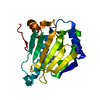 7s98C  7s99C 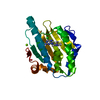 7s9fC 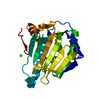 7s9gC  7s9hC  7s9iC 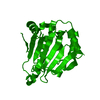 1yerS S: Starting model for refinement C: citing same article ( |
|---|---|
| Similar structure data | Similarity search - Function & homology  F&H Search F&H Search |
- Links
Links
- Assembly
Assembly
| Deposited unit | 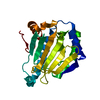
| ||||||||||||
|---|---|---|---|---|---|---|---|---|---|---|---|---|---|
| 1 |
| ||||||||||||
| Unit cell |
|
- Components
Components
| #1: Protein | Mass: 26739.922 Da / Num. of mol.: 1 Source method: isolated from a genetically manipulated source Source: (gene. exp.)  Homo sapiens (human) / Gene: HSP90AA1, HSP90A, HSPC1, HSPCA / Production host: Homo sapiens (human) / Gene: HSP90AA1, HSP90A, HSPC1, HSPCA / Production host:  References: UniProt: P07900, non-chaperonin molecular chaperone ATPase |
|---|---|
| #2: Water | ChemComp-HOH / |
-Experimental details
-Experiment
| Experiment | Method:  X-RAY DIFFRACTION / Number of used crystals: 1 X-RAY DIFFRACTION / Number of used crystals: 1 |
|---|
- Sample preparation
Sample preparation
| Crystal | Density Matthews: 2.81 Å3/Da / Density % sol: 56.28 % |
|---|---|
| Crystal grow | Temperature: 291 K / Method: vapor diffusion, sitting drop Details: 100 mM HEPES, pH 7 and 1.6 sodium citrate dihydrate |
-Data collection
| Diffraction | Mean temperature: 278 K / Serial crystal experiment: N |
|---|---|
| Diffraction source | Source:  SYNCHROTRON / Site: SYNCHROTRON / Site:  APS APS  / Beamline: 22-ID / Wavelength: 1 Å / Beamline: 22-ID / Wavelength: 1 Å |
| Detector | Type: DECTRIS EIGER X 16M / Detector: PIXEL / Date: Sep 1, 2020 |
| Radiation | Protocol: SINGLE WAVELENGTH / Monochromatic (M) / Laue (L): M / Scattering type: x-ray |
| Radiation wavelength | Wavelength: 1 Å / Relative weight: 1 |
| Reflection | Resolution: 1.64→34.89 Å / Num. obs: 35591 / % possible obs: 95.38 % / Redundancy: 4.7 % / Biso Wilson estimate: 21.84 Å2 / CC1/2: 0.987 / Rmerge(I) obs: 0.092 / Net I/σ(I): 9.91 |
| Reflection shell | Resolution: 1.64→1.7 Å / Rmerge(I) obs: 0.092 / Num. unique obs: 3593 / CC1/2: 0.469 |
- Processing
Processing
| Software |
| |||||||||||||||||||||||||||||||||||||||||||||||||||||||||||||||||||||||||||||||||||||||||||||||||||||||||
|---|---|---|---|---|---|---|---|---|---|---|---|---|---|---|---|---|---|---|---|---|---|---|---|---|---|---|---|---|---|---|---|---|---|---|---|---|---|---|---|---|---|---|---|---|---|---|---|---|---|---|---|---|---|---|---|---|---|---|---|---|---|---|---|---|---|---|---|---|---|---|---|---|---|---|---|---|---|---|---|---|---|---|---|---|---|---|---|---|---|---|---|---|---|---|---|---|---|---|---|---|---|---|---|---|---|---|
| Refinement | Method to determine structure:  MOLECULAR REPLACEMENT MOLECULAR REPLACEMENTStarting model: 1YER Resolution: 1.64→34.89 Å / SU ML: 0.1497 / Cross valid method: FREE R-VALUE / σ(F): 1.35 / Phase error: 16.2983 Stereochemistry target values: GeoStd + Monomer Library + CDL v1.2
| |||||||||||||||||||||||||||||||||||||||||||||||||||||||||||||||||||||||||||||||||||||||||||||||||||||||||
| Solvent computation | Shrinkage radii: 0.9 Å / VDW probe radii: 1.11 Å / Solvent model: FLAT BULK SOLVENT MODEL | |||||||||||||||||||||||||||||||||||||||||||||||||||||||||||||||||||||||||||||||||||||||||||||||||||||||||
| Displacement parameters | Biso mean: 31.18 Å2 | |||||||||||||||||||||||||||||||||||||||||||||||||||||||||||||||||||||||||||||||||||||||||||||||||||||||||
| Refinement step | Cycle: LAST / Resolution: 1.64→34.89 Å
| |||||||||||||||||||||||||||||||||||||||||||||||||||||||||||||||||||||||||||||||||||||||||||||||||||||||||
| Refine LS restraints |
| |||||||||||||||||||||||||||||||||||||||||||||||||||||||||||||||||||||||||||||||||||||||||||||||||||||||||
| LS refinement shell |
| |||||||||||||||||||||||||||||||||||||||||||||||||||||||||||||||||||||||||||||||||||||||||||||||||||||||||
| Refinement TLS params. | Method: refined / Origin x: -32.010724388 Å / Origin y: 14.9432731438 Å / Origin z: -20.2495611569 Å
| |||||||||||||||||||||||||||||||||||||||||||||||||||||||||||||||||||||||||||||||||||||||||||||||||||||||||
| Refinement TLS group | Selection details: all |
 Movie
Movie Controller
Controller



 PDBj
PDBj




















